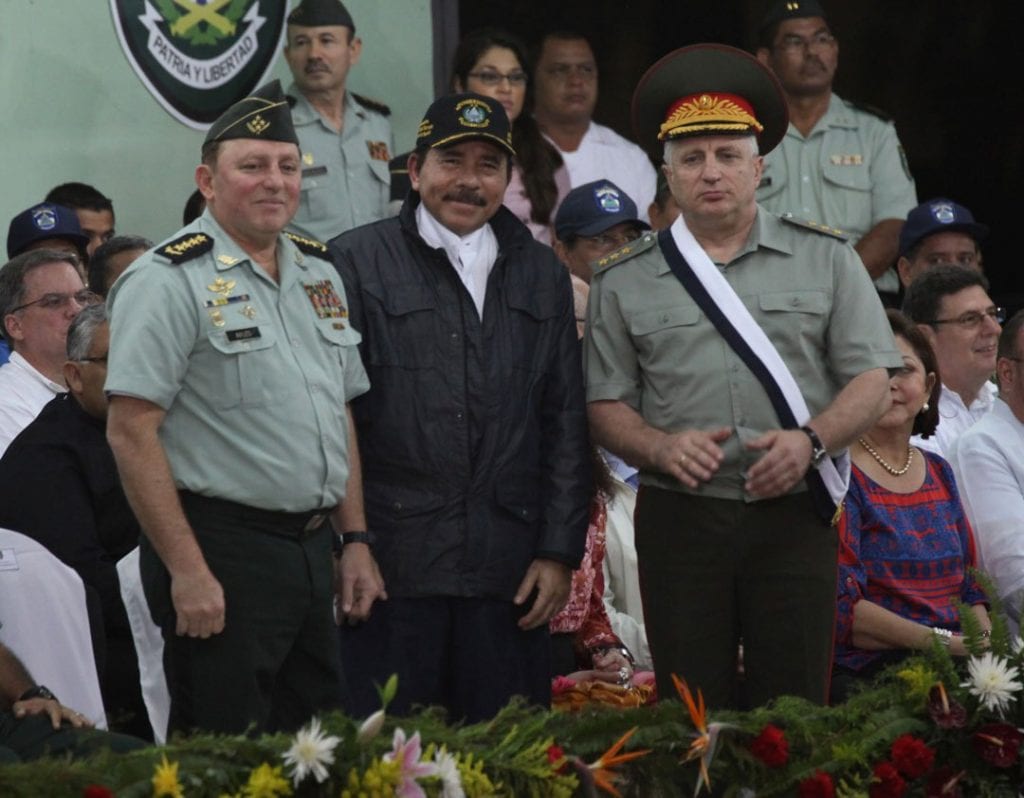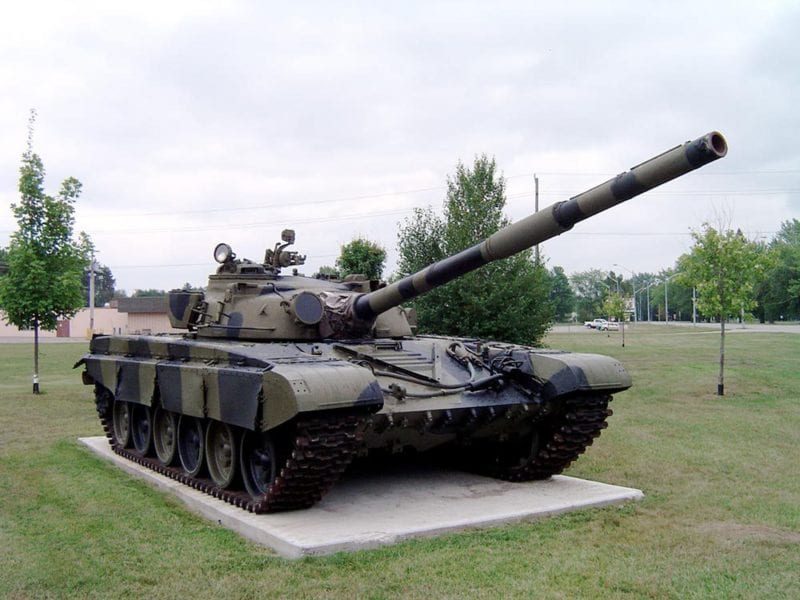Nicaragua Invests $80 Million in 50 Russian Tanks
National Assembly denies knowledge of any loans. Defense expert calls it “an irresponsible waste.”
By Wilfredo Miranda Aburto (Confidencial)

HAVANA TIMES – The Russian news agency “Sputnick” was the first to inform that Vladimir Putin’s government will be sending fifty T-72B1 combat tanks to Nicaragua as part of a bilateral technical-military cooperation agreement between the two countries. According to the Moscow-based source, the transaction has a price tag of $80 million US dollars; however, the National Assembly hasn’t approved any loans to cover this military expense.
A spokesperson for the Center for Analysis of World Arms Trade told the Russian agency that the first lot of 20 armored tanks was ready for shipment to Nicaragua. The full contract should be completed by the end of this year or the beginning of 2017.
Colonel Manuel Guevara Rocha, spokesman for the Nicaraguan Army, stated that the purchase of these tanks forms part of the military institution’s “modernization plan”. “For several years now, we’ve been carrying out activities aimed at the renewal of equipment that has outlived its usefulness,” the official briefly stated.
Guevara “didn’t have the details” regarding the financing of this million-dollar purchase of the T-72’s. “I can only say that the purchase is within the Army’s modernization plan,” he repeated.
Deputy Javier Vallejos, president of the National Assembly’s Peace, Defense and Governance Commission, showed surprise at the news of the acquisition of these tanks, since as far as he knows, Parliament hasn’t approved a loan for this.
“No such loan has gone through the Economic commission, much less through Governance (…) unless it’s gone through disguised,” Vallejos said. “Can you imagine the uproar that would have ensued if Walmaro Gutiérrez had received a request for loans to pay for war tanks? The media would have found out and we would have denounced it,” added the opposition deputy.
Wálmaro Gutiérrez, FSLN deputy and president of the Economic Commission, didn’t return Confidencial’s calls. Legislator Eliseo Nuñez, member of the commission presided over by his Sandinista colleague Gutiérrez, indicated that they knew of no loan for tanks.
The information from Russia didn’t specify whether these tanks were purchased through a credit or in cash; or if it was a military donation from Russia. Nuñez explained that if the Army bought them using money already included in the arms budget, they wouldn’t have to inform the National Assembly. But in the case of a credit, the military would be obligated to submit it to Parliamentary oversight.

According to the “Sputnik” agency, a contract is also in progress for the provision of two Molnia guided missile cruisers, the most costly purchase of the bilateral technical-military cooperation. Security expert Roberto Cajina stated that each launcher was worth 45 million dollars.
In 2013, the Navy also commissioned four 14310 Mirazh patrol boats from the Russians. These were earmarked for patrolling the Caribbean waters, which the International Court of Justice has declared to be under Nicaraguan sovereignty.
“In other words, this $80 million for the tanks is apart from the value of those missile carriers… Each cruiser – stripped, and without munitions or military training – is worth 45 million. Then you have to buy spare parts and train the mechanics,” Cajina noted, “That is, it’s a lot more expensive. We could be talking about 250 million dollars,” the expert added.
Irresponsible expense
Cajina feels that the purchase of the boats was necessary, since the Naval Forces “is in ruins” and needs these as a means to patrol the Caribbean Sea.
Nonetheless, the acquisition of the tanks seems to him “an inexplicable and irresponsible waste.” For this expert, the tanks have no value in terms of defending the national sovereignty and territorial integrity.
As Cajina explained, tanks are for conventional warfare between countries, but there’s no indication in the short, medium or long term that Nicaragua would get involved in this kind of military conflict.
The Army possesses 55 tanks of the T55 model, also Russian make. Two of them, Cajina stated, are only used for the parade each September 2, Nicaraguan Army Day.
Colonel Guevara justified the purchase of the tanks under the argument that the Army has always had armored vehicles and that they merely replace the tanks that “have served their purpose.” “It’s nothing more than a process of equipment renewal,” he insisted.
Cajina finds it absurd to equip the Army for war when the tendency is for international conflicts to be resolved by International Law in tribunals such as The Hague.
“The most serious issue is that [Daniel] Ortega is just giving little toys to the military, to General Aviles. They’re tanks that are going to remain parked, that are never going to come out, except for military parades,” said Cajina, who rejected any notion that the Russians would donate such costly armaments: “They give you lesser things, like anti-aircraft defense equipment or an aircraft simulator.”
Deputy Vallejos sustained that the purchase of these tanks would cause a great impact in Nicaragua. In his judgment, other, more serious problems like the drought need tackling, and the money could have been used to offer producers technical assistance and financing.
“At a time when there are great needs in this country, this President goes and buys tanks as if we were in wartime, as if the country were under threat, and as if we had money to spare with so much poverty,” the opposition legislator criticized.
Nicaraguan Ambassador to Russia “impressed” by the tanks
Ortega’s government first showed interest in the T-72B1 tanks in July 2015, when the Nicaraguan army participated in the “World Tank Biathlon” (something like a tank Olympics) in the city of Alabino, located about 50 kilometers from Moscow.
Juan Ernesto Vásquez Araya, Managua’s ambassador to the Kremlin, was “dazzled” at seeing how the T-72’s functioned, and told the Russian media that “a purchase was under discussion.”
“We hope that our army will soon receive the T-72. I believe that we can speak of a purchase,” Araya said in mid-2015. Months later, the purchase was finalized for the sum of 80 million dollars.
The Nicaraguan Army participated last year in the “World Tank Biathlon”, an activity that’s become increasingly popular in Russia and is held in several cities in that country.
According to the Russian state news agency Ria Novosti, 11 million people attended the armored vehicle games in 2015. The Nicaraguan diplomat expressed the intention of broadening the Nicaraguan Army’s participation in 2016.
The competition involves having the tanks maneuver and overcome different obstacles, such as posts, escarpments, land barriers and anti-tank ditches, all along a track. In 2015, 15 countries participated: Angola, Armenia, Belorussia, China, Egypt, India, Kuwait, Kirgizstan, Mongolia, Nicaragua, Pakistan, Russia, Serbia, Tadzhikistan, and Venezuela. Russia beat out China in the final round.
With the collaboration of Xavier Mantica.






Hi Lynn,
The Russians have expertise in tanks and their use. Remember how they successfully crushed the revolution in Hungary in 1956. They did the same thing again in Czechoslovakia in 1968 when Fidel Castro made savage criticism of the revolutions leader Alexander Dubchek for permitting freedom of the press enabling them to criticize socialism. Then they supplied the tanks for the invasion of Israel by Asads Syrian regime and the Castros supplied 500 Cuban tank drivers. Of course that was the “Yum Kippur War” was lost by Asad and the Castros, so it is never mentioned in Cuba and those Cubans who died are not given a day of honour. When you speak of “Warmongering” I trust that you are including:
1959 Dominican Republic
1961 Ghana
1963 Algeria
1964-5 Zaire
1965 Congo
1966-74 Guinea-Bissau
1973 Syria
1973 Yemen
1975-89 Angola
1978 Ethiopia
1980’s Nicaragua
1980’s El Salvador
1988-89 Mozambique
These were all actions of the Castro family regime and thousands died. Do these actions qualify as war-mongering? Or alternatively are they justified as there purpose was to install dictatorships by the left?
I don’t understand. Who is the enemy. Is this government a “me-too” copy of this United Regime Change Warmongering States of America?